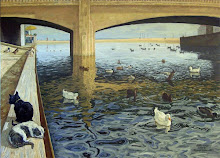When I was a young artist I took inspiration from Japanese prints. Browsing, one night at Rizzoli’s, I saw three little books full of such prints. I bought them; the first ones I’d ever bought. I enjoyed those works’ beauty of design, their liveliness of color and movement, their truthfulness of incident, and their humor. Over the years I have enjoyed leafing through their pages many times. I’m sure they have inspired and influenced my outlook on art.
One of the three books, full of the work of the exquisitely elegant Kiyonaga, shows an image that has remained poignant and dear to my heart from the moment I saw it. It is the one showing the comparison of the way boys play and the way girls play. See it below.

When I first encountered this image, at the age of 19, I knew it to be absolutely truthful. I had no sophistication, education, or the experience of childhood from the perspective of a parent. But I knew what a boy was, and I knew what a girl was, and that print appeared to show the truth anyone could see about boys and girls.
Many years later I became a parent. By that point, my growing life experience had shown me that boys need not be expected to act just like boys, and girls need not be expected to act just like girls. That we don’t need to encourage behavior that might seem stereotypically assigned to their respective sexes. Imagine my surprise when my boy started acting like a boy. Imagine my surprise when my girl started acting like a girl.
This afternoon some friends held a picnic, which I attended with my children. At a certain point I decided to photograph the children at play. My mind went back to the Kiyonaga print instantly when I saw the girls playing a tranquil game, and the boys playing at something more like warfare than anything else.

Through the magic of digital photography: the girls playing like Kiyonaga’s girls.

Through the magic of digital photography: the boys playing like Kiyonaga’s boys.
Kiyonaga and the camera don’t lie.







No comments:
Post a Comment